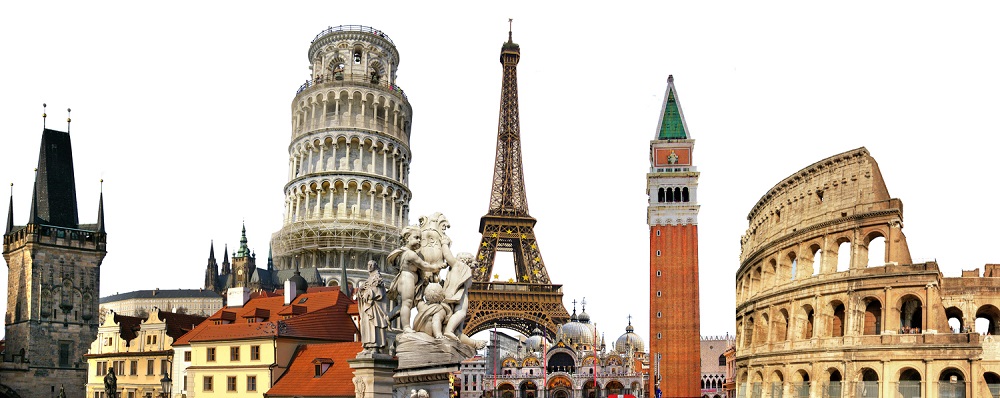
Definitions :
- Heritage : inheritance transmitted by way of succession /by previous generations.
- Culture : set of habits, traditions, beliefs and lifestyle that characterize a society or group of people.
- Cultural heritage : All material or immaterial goods with artistic or historical value.
- Cultural identity : it refers to the process of appropriation and sharing by the individual of the cultural elements of his environment.
CULTURAL IDENTITY : FROM MONUMENT TO CULTURAL ASSET
Not only does war cripple the economy and politics, but on a deeper level, it taints society and forever alters the cultural identity of those people. They are forced to migrate for the sake of their safety and a better future, carrying their culture with them, but in the process altering it.
- Cultural asset : the ways of living developed by a community and passed on from generation to generation, including customs, practices, places, objects, artistic expressions and values. It is often expressed as either Intangible or Tangible Cultural heritage / asset.
The first use of the term “cultural asset” in an official document was in the 1954 HAGUE CONVENTION, convened under the patronage of UNESCO to agree on the protection of cultural assets in case of armed conflict. It contemplated movable and immovable assets with great importance for the culture of the peoples.

In 1972, UNESCO proposed a new classification of cultural assets:
- Monuments : architecture, sculpture, painting, archeology, caverns, inscriptions, elements of universal value from the point of view history, art or science.
- Sets : groups of constructions, whose architecture and integration with the landscape give them exceptional value from the historical, art of science point of view.
- Places : works of man and nature with universal value from the historical, aesthetic, ethnological or anthropological point of view.
Why preserving heritage?
Nowadays, it is clear that culture has the power to transform societies. Its diverse manifestations ranging from our treasured historical monuments and museums to traditional practices and contemporary art forms enrich all aspects of our daily lives in countless ways. Heritage is a source of identity and cohesion for communities disrupted by accelerating change and economic instability. Creativity contributes to building open, inclusive and pluralistic societies. Heritage and creativity both contribute to founding dynamic, innovative and prosperous knowledge societies.
The VALUES of Heritage:
• cultural value
• artistic value/aesthetic value
• historical value
• value of authenticity
• value of antiquity
•functional/social value
• economic value

What should be preserved?
- Protection of values: we shouldn’t just protect the physical architectural heritage but also it’s values and what it represents and means (historic, artistic, antiquity, functional, economic…)
- Physical conservation : Every aspect of a building must be valued and taken care of:
- construction techniques.
- shapes and dimensions.
- colours, materials and textures.
- environment.
- use.
- Enhancement (valorisation): Make the building show and explain its values.
How to preserve?
Legislative instruments:
- Protecting (laws, rules) : Legal actions, administrative rules outside the intervention on the monument itself.
- Inventoring : a inventory is the result of enumerating, locating and describing the assets of a specific extent. It constitutes a first instrument for preventive conservation.
- Cataloguing : Cataloguing involves the enumeration, description and location of a property, but also it provides a historical study and economic valuation of a Heritage Resource.
Actions of interventions:
- Preservation of the environment :Operations to be performed on the good to ensure its survival against hazards or possible damages (environmental incidences, weather…). Equivalent to conserve but with more emphasis on the preventive aspect.
- Maintenance: Continuous and gradual maintenance, through punctual repairs, in a state of efficiency, in conditions to be used. An operation designed to prolong and maintain as long as possible the materials from which the object is made. It includes cleaning common areas, removing trash regularly, and repairing items that are broken. It can involve inspecting, repairing, and maintaining electrical systems, heating and air conditioning systems, and other utility services.
- Repairing : The restoration of an asset or a component to such a condition that it may be effectively utilised for its designed purpose by the overhaul, reprocessing or replacement of constituent parts or materials that have deteriorated by action of the elements or usage and have not been corrected by maintenance.
- Consolidation : Process which aims to restore the structural characteristics of a building which may be lost over time due to degradation, atmospheric and seismic agents.
- Renovation : It is defined as the structural and technical restoration, or modernisation of one or several floors or even an entire existing structure. On the one hand, it can focus on maintenance, but also on resolving flaws (partial renovation).
- Adaptation : Adaptation means the ability to fit. Building adaptation in construction can be defined as an intervention to adjust any work done on a building above the intention of maintenance that brings changes in the capacity, the function and the performance of the building.
- Reconstruction : the returning of a damaged building to a known earlier state by the introduction of new materials.
- Anastylosis : It is an archaeological term that refers to the technique of reconstructing a monument in ruins through the methodical study of the adjustment of the different elements that make up its architecture.
- Restoration : process of returning a building to its former state.Restoration work is most commonly undertaken on historic buildings; accurately recreating its form, features and character as it appeared at a particular time, while protecting its heritage value.